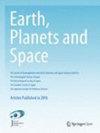Solidified magma reservoir derived from active source seismic experiments in the Aira caldera, southern Kyushu, Japan
IF 2.5
3区 地球科学
引用次数: 0
Abstract
Abstract The Aira caldera, located in southern Kyushu, Japan, originally formed 100 ka, and its current shape reflects the more recent 30 ka caldera-forming eruptions (hereafter, called the AT eruptions). This study aimed to delineate the detailed two-dimensional (2D) seismic velocity structure of the Aira caldera down to approximately 15 km, by means of the travel-time tomography analysis of the seismic profile across the caldera acquired in 2017 and 2018. A substantial structural difference in thickness in the subsurface low-velocity areas in the Aira caldera between the eastern and western sides, suggest that the Aira caldera comprises at least two calderas, identified as the AT and Wakamiko calderas. The most interesting feature of the caldera structure is the existence of a substantial high-velocity zone (HVZ) with a velocity of more than 6.8 km/s at depths of about 6–11 km beneath the central area of the AT caldera. Because no high ratio of P- to S-wave velocity zones in the depth range were detected from the previous three-dimensional velocity model beneath the AT caldera region, we infer that the HVZ is not an active magma reservoir but comprises a solidified and cool remnant. In addition, a poorly resolved low-velocity zone around 15 km in depth suggests the existence of a deep active magma reservoir. By superimposing the distribution of the known pressure sources derived from the observed ground inflation and the volcanic earthquake distribution onto the 2D velocity model, the magma transportation path in the crust was imaged. This image suggested that the HVZ plays an important role in magma transportation in the upper crust. Moreover, we estimated that the AT magma reservoir in the 30 ka Aira caldera-forming eruptions has the total volume of 490 km 3 DRE and is distributed in a depth range of 4–11 km. Graphical Abstract日本九州南部Aira火山口活源地震实验下的固化岩浆储层
Aira火山口位于日本九州南部,形成于100ka,其现在的形状反映了最近30ka的火山口形成喷发(以下称为AT喷发)。本研究旨在通过对2017年和2018年获得的横跨火山口的地震剖面的走时层析成像分析,描绘出Aira火山口详细的二维(2D)地震速度结构,深度约为15公里。在艾拉火山口的东西两侧的地下低速区,厚度的结构差异表明艾拉火山口至少由两个火山口组成,分别被确定为at和Wakamiko火山口。火山口结构最有趣的特征是在at火山口中心区域下方约6-11公里深处存在一个速度超过6.8公里/秒的高速带(HVZ)。由于以前的三维速度模型在AT破火山口区域下的深度范围内没有探测到高的P波与s波速度带,我们推断HVZ不是一个活跃的岩浆库,而是一个凝固的冷残余。此外,在深度约15公里处有一个分辨率较差的低速带,表明存在深部活动岩浆储层。通过将地面膨胀观测得到的已知压力源分布和火山地震分布叠加到二维速度模型上,对地壳内岩浆运移路径进行了成像。这幅图像表明HVZ在上地壳的岩浆输送中起着重要的作用。此外,我们估计了30 ka Aira造火山口喷发中AT岩浆储层的总积为490 km 3 DRE,分布在4 ~ 11 km的深度范围内。图形抽象
本文章由计算机程序翻译,如有差异,请以英文原文为准。
求助全文
约1分钟内获得全文
求助全文
来源期刊

Earth, Planets and Space
地学天文-地球科学综合
CiteScore
5.80
自引率
16.70%
发文量
167
期刊介绍:
Earth, Planets and Space (EPS) covers scientific articles in Earth and Planetary Sciences, particularly geomagnetism, aeronomy, space science, seismology, volcanology, geodesy, and planetary science. EPS also welcomes articles in new and interdisciplinary subjects, including instrumentations. Only new and original contents will be accepted for publication.
 求助内容:
求助内容: 应助结果提醒方式:
应助结果提醒方式:


